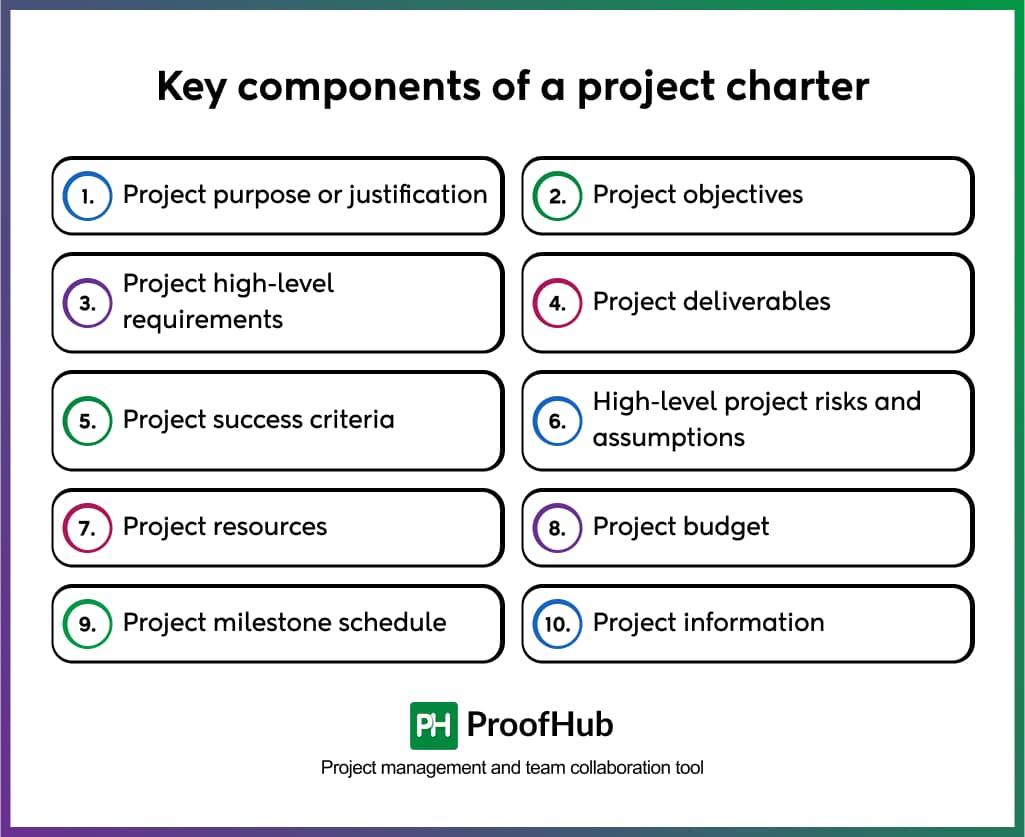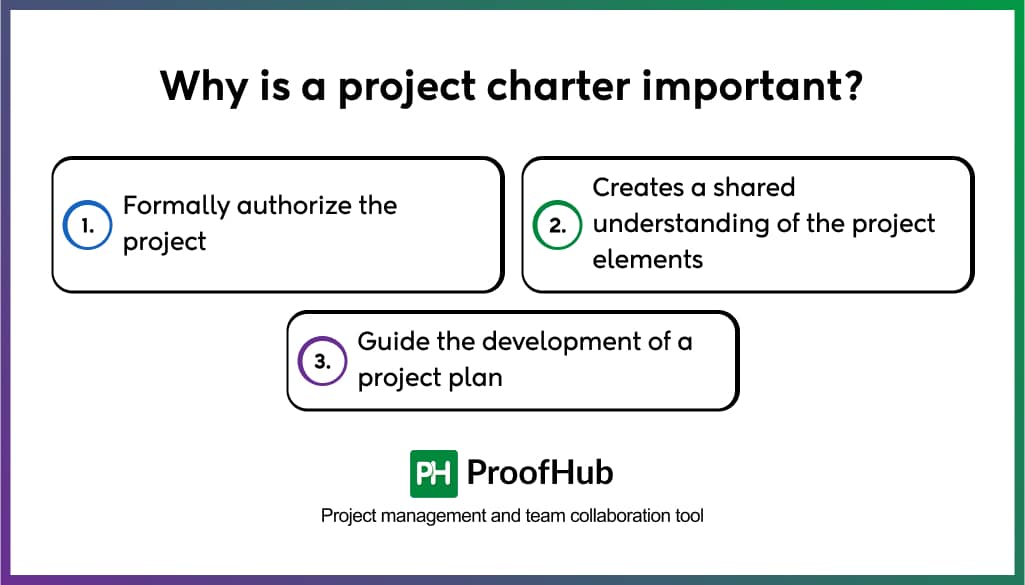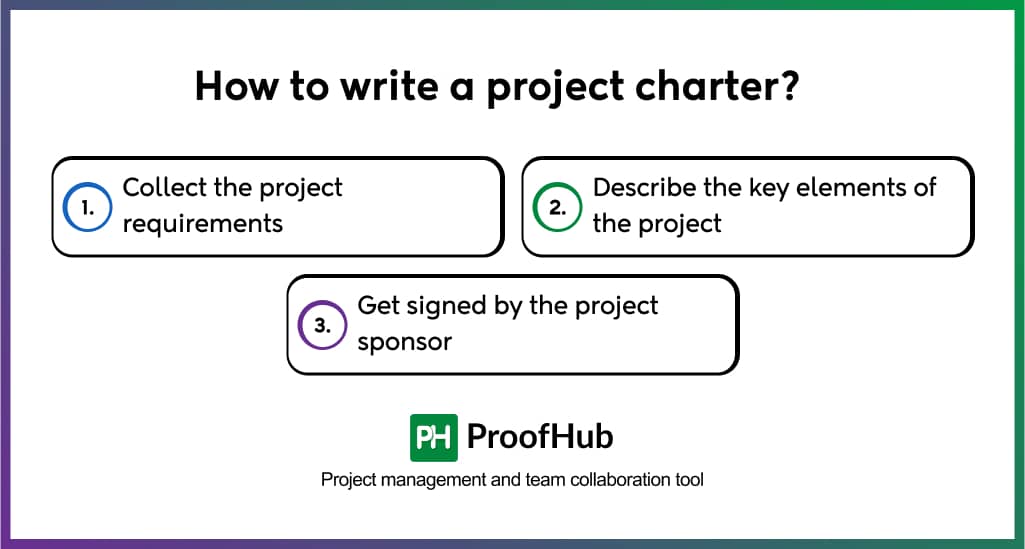A project charter is a formal document that authorizes the existence of a project and provides authority to a project manager to initiate work on the project. This simple and short definition is good for the sake of understanding, but if one really wants to know how a project charter works, how to create and write a project charter, and the importance of a project charter in the project’s success, one needs to dig deep and understand every tiny element of the project charter.
In this beginner’s guide to project charter, we have covered all the basic aspects to help you understand and create an effective project charter that contributes to project success throughout.
Just to inform you, many managers out there create a project charter that brings confusion and conflicts rather than clarity and shared understanding (the purpose of the project charter). To create a valuable and effective project charter, you need to know how it functions.
What is a project charter in project management?
A project charter is a document that formally authorizes a project and gives authority to a project manager to start working on the project. A project charter primarily includes and outlines the project’s purpose, scope, goals, objectives, requirements, deliverables, stakeholders, acceptance criteria, resources, risks, milestone schedule, and budget of the project.
It is a key document that marks the beginning of the project planning phase, where a project manager develops a project plan based on the details outlined in the project charter.
A project charter in project management formally assigns a project manager to a project and names the sponsor or authority who signs the project charter to authorize the project.
Apart from formal authorization, the purpose of creating a project charter is to outline all the high-level requirements of the project, identify and involve the key stakeholders of the project, and create a shared understanding with the project stakeholders on the project requirements, expectations, and details before actually starting work on the project.
A Free guide to help you with proven ways to lead a project from start to finish, without confusion or jargon.

What are the key components of a project charter?
A project charter defines the initial and high-level requirements of a project, as well as the needs and expectations of stakeholders regarding the project. It has the following key elements:

- Project purpose or justification: It defines why we are undertaking this project and how we are going to benefit from this project. Or in simple terms, it defines what problems a project is solving (Business Case).
- Project objectives: It defines the goals and objectives of a project in a measurable way. This defines what we are aiming to achieve.
- Project high-level requirements: It defines the scope of the work to be performed in a project (Statement of Work). It provides an overview of what is included and not included in a project, defining the boundaries and constraints of a project. This forms the basis of project deliverables, project plan, and project success criteria.
- Project deliverables: It defines the outcomes or the delivered services and products at the end of the project, marking the completion of the project.
- Project success criteria: It defines the approval requirements, the acceptance criteria, and the success metrics for the project deliverables. This sets the right expectations for the project team on what to deliver and also for the project stakeholders on what to expect and what defines project success.
- High-level project risks and assumptions: It defines the high-level risks that are most likely to happen in the project and assumptions considered to be true for the project to proceed.
- Project resources: It defines the high-level estimation of the resources required for the project. Resources include human, financial, technology, space, and infrastructure.
- Project budget: It identifies a general overview of the project budget.
- Project milestone schedule: It defines key deadlines, major phases, and key milestones of a project.
- Project information: It includes general information related to a project, such as a project name, high-level project description, project sponsors, project team members, project stakeholders, and a project manager.
Read more: What is the project management triangle?
Why is a project charter important?
A project charter is important in a project because it formally authorizes and recognizes the existence of a project, creates a shared understanding for the project stakeholders, and guides the development of a project plan.

1. Formally authorize the project
A project charter is a document of formal authorization of a partnership between the project performing organization and the project requesting organization. In the case of an internal project, it is a document of authorization between the project initiators (sponsors) and the project manager. Once a project charter is approved and signed, it means the project performing organization and the requesting organization agree to the terms and conditions mentioned in the project charter. In the case of an internally requested project, it is an agreement between the project sponsors and the project manager. This helps avoid disputes and conflicts related to the project’s deliverables, scope, and resources during the execution and delivery of the project.
2. Creates a shared understanding of the project elements
A project charter contains the details of the project’s purpose, scope, stakeholders, resources, success criteria, and other key aspects of the project. A clearly documented project charter helps create a shared understanding for the key stakeholders on the key elements of the project. Project key stakeholders are aware and on the same page about the expectations of the project, decision-making authorities, and resources required for the project. This shared understanding removes operational inefficiencies, makes quick project decisions, and identifies the gaps prior to the project planning, if any, increasing the likelihood of the project’s success.
3. Guide the development of a project plan
A project charter is a key input document for the project plan. It provides the description of all six constraints of the project (scope, cost, time, quality, risks, and benefits), key stakeholders, and roles, responsibilities, and decision-making authorities of individuals. The information in a project charter acts as a foundation to create a detailed project plan. Based on the requirements in a project charter, a project manager defines the scope, deliverables, and acceptance criteria, creates a work breakdown structure, estimates the resources required for a project, creates baselines to track progress, identifies risks and plans mitigation strategies, and develops project schedules to create a project plan.
Read more: Steps to create a project management plan
How to write a project charter?
Creating a project charter is a comprehensive process and varies slightly from one organization to another. However, some common steps are followed by almost every organization. Here is a detailed step-by-step process to create a project charter:

1. Collect the project requirements
The first step to create a project charter is to gather the project requirements. To collect the details, a project manager requests the statement of work (SOW) from the project sponsors. The statement of work is a document that outlines the products or services to be delivered by the project.
For internal projects within an organization, a project sponsor or initiator writes the statement of work, defining the need for products or services to be delivered by the project, and outlines the project requirements. In case of an external project, the needs and requirements of the project are gathered through a request for proposal, where a client describes the description of product or services to be delivered by the project.
The next key document a project manager needs to create a project charter is the business case. It is one of the most important documents that defines whether a project is financially feasible or not by performing the cost-benefit analysis of the project. Based on the findings of a business case, project sponsors approve or reject the project.
The third step of collecting project requirements is to identify and document the key stakeholders of the project. This ensures all the stakeholders are involved in the creation of the project charter.
2. Describe the key elements of the project
Once a project manager has the project requirements, business case, and stakeholder register, the project manager begins with the process of writing a project charter by involving stakeholders & subject matter experts, considering organizational processes and environments, using expert judgment, and referring to the previous project data.
A project manager starts with the project’s basic information, such as project name, description, start date, ID, sponsors, and the project manager. A project manager defines the project purpose, objectives, and goals. This helps in determining the project’s high-level requirements, deliverables, scope, success criteria, assumptions, and risks of the project. Based on these, a summary milestone schedule and summary budget are created.
3. Get signed by the project sponsor
After drafting the project charter, the project manager sends it for the approval of the project initiator. A project initiator’s signature on the project charter authorizes the project. An initiator can be a sponsor, PMO, or portfolio steering committee. If there are some refinements, the project initiator will request the changes. If not, a project charter is signed, and a project manager is assigned and given the authority to apply resources to project activities and start working on the project.
Tips for writing a project management charter
Not all project charters are well-crafted. Many managers write it just for the sake of writing to get formal authorization. To write an effective project charter that is viable and valuable throughout the project, here are some quick tips you can keep in mind:
- Have discussions with project sponsors to get clarity on stakeholders’ needs and expectations, and project requirements. You can call it a project charter storming session where you gather key stakeholders in a room (virtual or physical) and collaboratively build the charter’s core components on a whiteboard.
- Use the SMART framework to write project goals in measurable form.
- Involve project team members to define the high-level project scope, risks, resource requirements, and schedule
- Involve subject matter experts while making estimations of resources, schedule, and budget
- Use expert judgment and refer to the previous project data to make informed decisions
- Consider organizational processes while creating a project charter
- Use a project charter template to start with, but customize it and tailor it to your organization’s processes and the project’s needs.
Pro tip: In a recent discussion initiated by me in the PMI community on the topic of how to write a Project Charter to make sure the document remains viable and valuable throughout the project lifecycle, Luis Branco, CEO, Business Insight, Consultores de Gestão, says, “My single most important suggestion: Co-create the Charter with key stakeholders instead of writing it alone.”
When people participate in defining purpose, scope, and success criteria, they develop ownership and clarity that no template can achieve.
This transforms the Charter into a mutual commitment, not a static authorization.
In practice:
– Facilitate short alignment workshops (A3-style or similar) to frame Purpose, Context, and Value.
– Keep it concise and review it at each major decision gate – update insights, not just dates.
– Use it to onboard new team members and to validate decisions against the original intent.
In one of my industrial transformation projects, a one-page co-created Charter became the team’s “north star”, revisited at every stand-up and steering meeting. It kept alignment alive even under changing conditions.
A well-crafted Charter doesn’t age
It regenerates meaning as the project evolves.
That’s when it stops being a document and becomes leadership in action.
Project charter examples
To better understand a project charter, here is an example of the website development project of the National Bank.
1. Project information
Project Name: National Bank Website Re-design
Project Title: Development of a customer-centric website for “National Bank”
Project ID: NB-WEB-2025
Date: October 25, 2025
Project Sponsor: Sarah Smith, Chief Operations Officer
Project Manager: David Rodriguez, Senior Project Manager
Key Stakeholders:
- Head of Marketing: Michael Brown
- Technical Lead: Vaibhav Srivastav (IT Director)
- Compliance Officer: Robert Davis (Legal & Compliance)
- Key Users: Marketing content team, Customer service representative
2. Project purpose/Business case
National Bank’s current website is outdated, with slow-loading speed, and is not mobile-responsive. This results in a poor user experience (UX), an increase in customer service calls, and a drop in online account opening. This project aims to improve the user experience of the website, reducing customer service calls, and improving digital engagement
3. Project objectives
- Reduce customer service calls for simple online tasks by 35%.
- Grow online account opening applications by 25%.
- Improving customer satisfaction regarding digital channels.
4. High-level requirements
In-scope:
- Design and development of a new website.
- Responsive design for desktop, tablet, and mobile devices.
- Integration with the existing online banking login.
- Implementation of a secure web application firewall (WAF) and SSL certificate.
- Compliance with WCAG 2.1 AA accessibility standards and banking regulations.
Out-of-scope:
- Redesign of the internal online banking portal or mobile app.
- Development of new backend core banking systems.
- Content creation, SEO, and marketing after launch.
5. Key deliverables
- UX/UI wireframes and mockups
- Functional website on a staging server
- Fully tested and launched production website
- CMS user training manual and session for the marketing team
- Technical documentation and project closure report
6. Success criteria
The project will be considered successful upon:
- On-time and on-budget launch.
- Meeting all success metrics, such as achieving a Google PageSpeed Score of 90+ on desktop and mobile, and achieving WCAG 2.1 AA compliance validated by a 3rd-party audit.
- Formal sign-off from the Project Sponsor.
7. High-level risks & assumptions
Assumptions:
- Key stakeholders will be available for review and feedback within agreed timelines.
- The current brand guidelines will remain stable during the project.
- No major changes in banking compliance regulations will occur during development.
Risks:
- High Risk: Scope creep from marketing stakeholders requesting new features.
- Mitigation: A strict change control process managed by the PM.
- Medium Risk: Delays in compliance/legal review of content.
- Mitigation: Early engagement with the compliance team and built-in buffer time.
- Medium Risk: Technical challenges with legacy system integration.
- Mitigation: Early technical spike/prototype of the integration points.
8. Budget & resources
- Initial budget: $250,000
- Source of funding: Digital Transformation Capital Budget
- Key resources:
- Project Manager (1.0 FTE)
- UX/UI Designer (1.0 FTE)
- Web Developers (2.0 FTE)
- Content Specialist (0.5 FTE)
- QA Tester (1.0 FTE)
- External Legal & Compliance Review
9. Milestone schedule
- Requirement gathering complete: November 17, 2025
- UX/UI design signed off: December 15, 2025
- Development & content migration complete: February 28, 2026
- User acceptance testing (UAT) complete: March 15, 2026
- Official public launch: April 2, 2026
10. Authorization
The undersigned acknowledge they have reviewed the contents of this Project Charter and authorize the commencement of “Project National Bank Website Re-design.”
____________________________
Sarah Smith, Project Sponsor
Chief Digital Officer, National Bank
Date: _________
____________________________
David Rodriguez, Project Manager
Senior Project Manager, National Bank
Date: _________
Read more: 15 Best Project Management Tools in 2025
What are the popular misconceptions about a project charter?
- Misconception 1: The Project Charter is just for the formal authorization for the PM to get permission to start.
- Reality: It’s for everyone. It aligns the project sponsors, team members, and other stakeholders on a shared vision to create a mutual understanding.
- Misconception 2: The Project Manager writes the charter.
- Reality: The Project Manager facilitates the creation of the charter and writes the draft, but the Project Sponsor is ultimately the owner and is responsible for the project charter.
- Misconception 3: The charter is the same as the project plan.
- Reality: The charter is the foundation, and the project plan is the detailed blueprint built on that foundation. The charter says “what” and “why,” the plan describes “how,” “when,” and “by whom.”
- Misconception 4: A project charter is set in stone and never changes once it’s signed.
- Reality: A project charter can and should be updated, or the project should be canceled if the business case changes fundamentally. This is done through a formal change control process, not casually.
- Misconception 5: “A charter is only needed for big, formal projects.”
- Reality: Even for small and simple projects, a one-page charter helps bring clarity and agreement. The scale of the charter can change, but the need for a shared understanding does not.
Who creates the project charter?
A project manager is responsible for creating the draft of the project charter. And the project sponsor is responsible for formally authorizing the project charter by signing it.
It is the responsibility and authority of the project sponsor to approve or reject the project charter. Whereas a project manager typically creates the draft, collaborating with the sponsor and other key stakeholders like business analysts, subject matter experts, and team members to ensure clarity on the project’s purpose, scope, objectives, and resources.
Is it necessary to create a project charter?
Not every organization needs to create a project charter. For small projects, organizations collect the project requirements and directly start creating a project plan. In large organizations with long and complex projects, a comprehensive project charter is created.
However, it is important to note that even in small organizations, the function of a project charter is involved in some way. It can be in terms of the statement of the work, project brief, or executive summary. Every organization has a document that formally collects the requirements of the project.
Project charter vs. project plan: What’s the difference?
A project charter outlines the high-level requirements of the project, whereas a project plan creates a detailed level plan of the project. For example, a project charter defines the key milestones of the project, but it does not talk about the schedule of tasks to achieve those milestones. These tiny details are reserved for the project plan. In layman’s terms, a project charter says “what” and “why,” the project plan describes “how,” “when,” and “by whom.”
How often should a project charter be updated?
A project charter should not be updated frequently because it is the foundation of the project on which a project plan is created. A good project charter considers all the aspects and provides a stable foundation. But it does not mean a project charter is set in stone. It is a “baseline of the baseline.” Updates are only required if a fundamental aspect of the project changes, such as a shift in business objectives, a major budget revision, or a change in core deliverables. This is typically managed through a formal change control process. If the project’s core purpose remains intact, changes should be handled in the project plan, not the charter.
What is the ideal length of the project charter document?
The ideal length of a project charter depends on the complexity, scale, and tenure of a project. For the sake of reference, the ideal length of a project charter should be 1 to 3 pages. However, a project charter can be as long as a 10-page document or as short as a 1-page document. Make sure it is long enough to clearly articulate the project’s purpose, objectives, scope, and key stakeholders, but short enough to ensure it is actually read and remembered.
How does a project charter reduce project risks?
A project charter reduces project risks by creating clarity and consensus among the stakeholders from the start. It mitigates key risks directly:
- Scope creep: Defining what is in and out of scope provides a clear boundary.
- Stakeholder conflict: By explicitly naming stakeholders and high-level requirements, it ensures everyone agrees on the core goals upfront.
- Resource shortages: By formally authorizing the project manager to use resources, it reduces the risk of being unable to secure team members or budget.
This early alignment prevents misunderstandings that are a primary source of major project risks later.
What is the role of a project charter in Agile project management?
In Agile, the project charter serves the same vital purpose: to authorize the project and align stakeholders on the “why.” However, its form is often lighter – sometimes called a “project canvas” or a single-page vision statement. It focuses on the project vision, high-level goals, and constraints (especially budget and timeboxes for releases), while leaving detailed requirements for the product backlog. It answers the question, “What valuable outcome are we trying to achieve for the customer?” This provides the Agile team with the strategic guardrails and autonomy they need to iterate effectively.
What to do once I finish writing my project charter?
After finishing writing the project charter, you should seek formal sign-off to formally authorize a project, conduct a project kick-off meeting with the team and key stakeholders to create a shared understanding, and start working on a project plan. To do so effectively, you need project management software to collaborate with the team and create a detailed project plan. Let’s find out how our project management software, ProofHub, helps you with the creation of a project charter and project plan, and the implementation of a project plan.
Create a project plan with ProofHub
ProofHub is an all-in-one project management and team collaboration software that brings people, projects, and documents to one place for effective teamwork.
Here is how ProofHub can help you:
- Start project discussions: Create a project, name it, and start project discussions. With ProofHub’s project discussion, you can brainstorm with stakeholders and team members on different topics. The platform allows you to share files in discussions to provide context. If you want to convert a key discussion into a task, you can do it in ProofHub.
- Create tasks and collaborate on tasks: Creating a project charter includes completing a variety of tasks. With ProofHub task management, you can create a task, collaborate on tasks with task comments and file sharing, and keep track of the due dates and status to complete work on time.
- Create a project plan: To create a project plan in ProofHub, you can use its various features to facilitate teamwork. You can create a list of tasks, assign owners to the task, and design a custom workflow for tasks. With project discussions, you can create a topic for discussion. For one-to-one real-time communication, ProofHub has a chat.
- Create a schedule using a Gantt chart: With ProofHub’s Gantt chart, you can visualize the project plan on a timeline, set the dependencies between tasks, assign resources to a task, create a baseline to track the progress, and evaluate the impact of delays on the project. This is one of the most important features for creating a project plan.
- Track progress with reports: With ProofHub, you can execute the project plan with the team. All the tasks of a project are displayed on the central board, where you can monitor the status in multiple views such as Table, Board, Calendar, and Gantt. Along with ProofHub’s time tracking and project reports, you can overview the project progress and team performance and make decisions based on the data.
To know more about how ProofHub can fit into your workflow, either schedule a product demo from one of our project management support experts or schedule a 14-day free trial!

